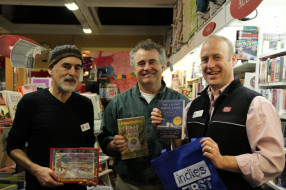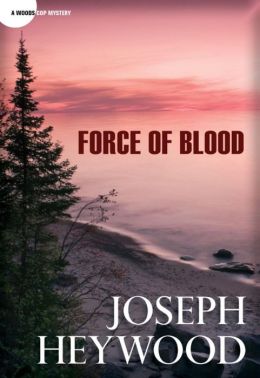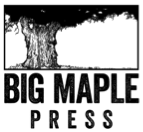If you own a bookstore you’d be very smart to hire me. I would never be late for work and would cheerfully clean the bathroom when necessary and add pennies from my own pocket to the take-a-penny dish. I would make your customers feel so welcome that they would run home and get their sleeping bags and come back to have a slumber party and maybe move in forever. I would have hundreds of books in mind to recommend and would run through most of them before I thought to recommend those I wrote myself. If any customers wanted to buy any of the books I recommended but didn’t have enough money I would loan it to them. When they countered with book recommendations of their own, as customers often do, I would buy them on the spot, probably two or three for every conversation. I would also buy ten or twelve new releases and classics and obscure translations every day because in my house we’ve been getting rid of furniture lately to make more room for books. Three times a day I would buy coffee and sandwiches on the premises because I would never want to leave the store. Also I would work for free.
So you can imagine how much fun I had last Saturday working the Indies First celebration at two of my favorite bookstores. Indies First is a national event championed by Sherman Alexie to draw support for independent bookstores everywhere, and it inspired 1,000 authors across the country to donate their time November 30 to work in 500 or so stores. I split the day between Horizon Books in Traverse City, Michigan and McLean & Eakin Booksellers 75 miles away in Petoskey. And I wasn’t alone. I teamed up with artist Glenn Wolff, who is on tour to promote his and Bob Sullivan’s A Child’s Christmas in New England (and Glenn has illustrated many of my books, including the newly updated It’s Raining Frogs and Fishes). Other writers and artists were there also, some of them on overlapping schedules, so in addition to chatting all day with customers I got to talk with some author/artist friends I haven’t seen in a while as well as a few new ones. It was fun comparing notes and learning who had books coming out and who had recently been given options for movies. It was even more fun talking about the books we’ve been reading.

Glenn Wolff (with A Child’s Christmas in New England), Jerry Dennis (with It’s Raining Frogs and Fishes), and Matt Norcross (with The Living Great Lakes) at McLean & Eakin Booksellers, Petoskey, MI
Matt and Jessilynn at McLean & Eakin had asked their visiting writers to provide them with a list of six books they wanted to recommend. They then ordered copies of them and displayed them along with the visiting authors’ books. I was delighted to see Glenn’s and my books displayed in stacks all over the store, including at the prime spots next to the cash register, in the staff recommendations section, and on the shelf over the stairway leading to the lower level. Like only independent bookstores can, they made Glenn and me feel like we’re maybe a little special. Combine that with how jazzed we were to talk about books, and we had a pretty great day.
Here’s my list of recommendations:
No Need of Sympathy: Poems, Fleda Brown (BOA Editions, 2013). Fleda’s a friend but that’s not why her book is on the list. I was pretty sure I was going to include it because of one poem: “The Kayak and the Eiffel Tower,” which I first read when it won a Pushcart Prize in 2009, then reread so many times that it started to seem like my favorite poem of all time. It’s a memory of childhood blended with a sort of dream to reproduce the incandescent perceptions of a child seeing the world in all its strangeness and perplexity. It’s haunting and beautiful and heartbreaking and musical. So are the rest of the poems in the book. I read it in one sitting – 84 pages while my coffee and oatmeal went cold on the table before me – then went back to page one and read it again. It’s up for a bunch of prestigious awards and I predict it will win.

The Maytrees, Annie Dillard (HarperCollins, 2007). I’ve been a fan of Dillard’s essays since Pilgrim at Tinker Creek, but for some reason was skeptical about her fiction. Holy crap, was I wrong. I wondered in a previous post how I had managed to live without this vivid and powerful exploration of love in all its forms. Months after finishing the book I had a dream in which I explained to someone that I loved it fiercely because “its language had entered my body and was flowing through my veins.” Weird. But somehow it seems true.

Death at the Lighthouse, Loren Graham (Arbutus Press, 2013). Graham’s A Face in the Rock: The Tale of a Grand Island Chippewa is a book I’ve recommended for years during my travels to talk about the Great Lakes, so I was stoked when Nancy Dwyer at Falling Rock Cafe and Bookstore handed me this second installment on the history of Lake Superior’s Grand Island. I bought it on the spot and read it in a gulp. Shortly after Graham and his wife purchased and restored the lighthouse at the north end of the island he began researching the 1908 murder of the lighthouse keeper and his assistant that took place there. It became his summer project (he was a college professor, now retired). The result, some forty years later, is a riveting and complex tale that draws on the history of the entire U.P. and brings the place and the era to life. The book is full of typos – I can’t understand why, in this age when it’s so easy to correct them – but I like the book so much that I found it easy to forgive them.

Brown Dog, Jim Harrison (Grove Press, 2013). For weeks I’ve been savoring an advance copy of this collection of novellas, the first five of which were published in collections spanning more than 20 years. Last winter I re-read them in sequence, and came away convinced that if they were published as a separate book they would form an epic 500-page novel that would one day be considered Harrison’s magnum opus. This volume includes a new novella, bringing the total to six. Brown Dog is a unique character in our literature and absolutely unforgettable. He’s a Yooper and most of the stories take place in the U.P. and couldn’t have taken place anywhere else. I recommend reading it with a six pack of Old Milwaukee and a bag of pork rinds.

The Dogstars, Peter Heller (Knopf, 2012). After Cormac McCarthy’s The Road, this is my favorite post-apocalyptic novel. The writing drew me in with its originality and unorthodox constructions, but the story kept me turning the pages. It’s a love story as well as a story of survival and hope. Of the many interesting characters, my favorite is a dog. I’ve read it twice this year.

Force of Blood, Joseph Heywood (Lyons Press, 2012). Credit for my late-arriving interest in crime fiction has to go to Heywood, whom I’ve met and corresponded with, and to Aaron Stander, author of half a dozen novels in the Ray Elkins mystery series, most recently Death in a Summer Colony (all of which I highly recommend). Heywood’s Woods Cop series features Grady Service, a DNR game warden, who takes on game violators, drug smugglers, plunderers of Native-American holy sites, and other scoundrels in the Upper Peninsula. I’ve been reading Heywood for a while now, and he keeps getting better — and more prolific. This year he published two new novels and collection of stories, all of which are on my Christmas list. I love that Heywood spends many weeks every year patrolling with game wardens in the U.P. No doubt it’s why he writes with such immediacy and verisimilitude. Plus he can flat-out tell a good stories.










7 Replies